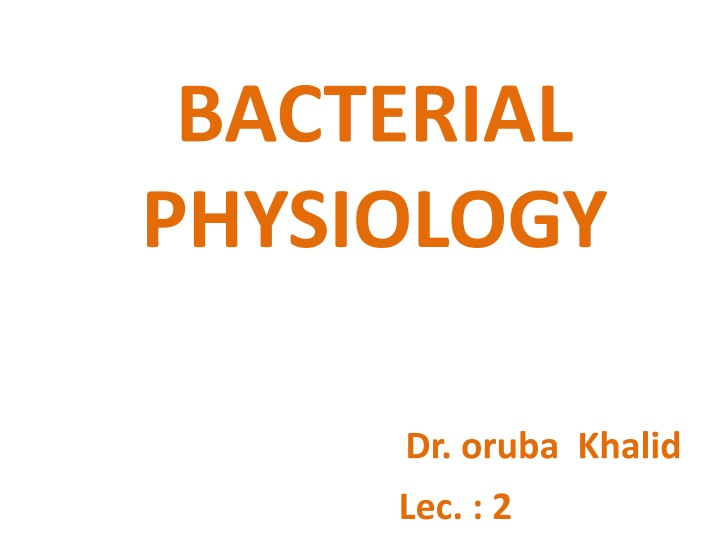
Bacterial Physiology and Metabolism
Explore the fascinating world of bacterial physiology and metabolism with Dr. Oruba Khalid. Learn about different types of bacterial metabolism, catabolic and anabolic reactions, and the essential processes like digestion, uptake, and oxidation. Discover how bacteria utilize nutrients and energy for growth, survival, and various metabolic functions.
Download Presentation

Please find below an Image/Link to download the presentation.
The content on the website is provided AS IS for your information and personal use only. It may not be sold, licensed, or shared on other websites without obtaining consent from the author. If you encounter any issues during the download, it is possible that the publisher has removed the file from their server.
You are allowed to download the files provided on this website for personal or commercial use, subject to the condition that they are used lawfully. All files are the property of their respective owners.
The content on the website is provided AS IS for your information and personal use only. It may not be sold, licensed, or shared on other websites without obtaining consent from the author.
E N D
Presentation Transcript
BACTERIAL PHYSIOLOGY Dr. oruba Khalid Lec. : 2
Vibrio Spirillum Mycoplasma
WHAT IS PHYSIOLOGY ? IT S THE GROWTH, NUTRITION AND METABOLISM
Bacterial Metabolism Types of Metabolism: Metabolism is the totality of chemical reactions occurring in bacterial cells. They can be subdivided into : A- Catabolic reactions that supply energy. B- Anabolic (synthetic) reactions that consume energy
-Catabolic reactions supply both energy and the basic structural elements for the synthesis of specific bacterial molecules. -In the anabolic reactions , the energy requirement is consumed in form of light or chemical energy by chemosynthetic bacteria, respectively. photosynthetic or
A-Catabolic Reactions -Organic nutrient substrates are catabolized in a wide variety of enzymatic processes that can be schematically divided into three phases: 1-Digestion: -Bacterial exoenzymes split up the nutrient substrates into smaller molecules outside the cell. The exoenzymes represent important pathogenicity factors in some cases. 2-Uptake: -Nutrients can be taken up by means of passive diffusion or, more frequently, specifically by active transport through the membrane(s).
3-Oxidation: -This process is defined as the removal of electrons and H+ ions. -The substance to which the H2 atoms are transferred is called the hydrogen acceptor.
-The two basic forms of oxidation are defined by the final hydrogen acceptor: A Respiration: -A series of reactions that convert glucose to CO2 and allow the cell to recover significant amounts of energy - Glucose + O2 Carbon dioxide + Water +Energy - C6H12O6 + O2 6CO2 + 6H2O + 38 ATP
B-Fermentation: -Here an organic compound serves as the hydrogen acceptor. -The main difference between fermentation and respiration is the energy yield, which can be greater from respiration than from fermentation for a given nutrient substrate by as much as 10 times .
B-Anabolic Reactions -Some bacteria (like E. coli) are capable of synthesizing all the complex organic molecules that they are comprised of from the simplest nutrients in a very short time. These capacities are utilized in the field of microbiological engineering. -Some bacteria are capable of using hydrocarbon compounds as an energy source.
Bacterial Nutrition Water constitutes 80% of the total weight of bacterial cells. Proteins, polysaccharides, lipids, nucleic acids & low molecular weight compounds make up the remaining 20%. For growth & multiplication, the minimum nutritional requirements are water, a source of carbon, a source of nitrogen & some inorganic salts
Classification based on nutrition 1. Autotrophs can synthesize all their organic compounds by utilizing atmospheric CO2 & N2. They have no medical importance. Based on nutrition , bacteria are classified as : 2. Heterotrophs unable to synthesize their own metabolites & depend on the organic compounds. All pathogenic bacteria are heterotrophs .
Nutritional Factors Some bacteria require certain organic compounds in minute quantities called as nutritional factors . It can be : 1. Essential Compounds that bacterial growth does not occur in their absence. 2. Accessory Compounds that enhance growth but without being absolutely necessary for it
Based on Nutritional Requirement Bacteria Can Be Classified As: Phototrophs Bacteria which derive their energy from sunlight. Chemotrophs Bacteria which derive energy from chemical reactions. Organotrophs : require organic sources of hydrogen Lithotrophs : require inorganic sources of hydrogen like NH3, H2S
OTHER GROWTH REQUIREMENTS 1. Vitamin B complex 2. Thiamine 3. Riboflavine 4. Nicotinic acid 5. Pyridoxine 6. Folic acid 7. Vit.B 12
BACTERIAL GROWTH It is an increase in all the cellular components, which multiplication of the cell leading to an increase in population. end in It involves an increase in the number of individual cells. Bacteria divide by binary fission.
Generation time Interval of time between two cell divisions OR The time required for a bacterium to give rise to 2 daughter cells under optimum conditions
Generation time of E.coli & other medically important bacteria is 20 mins For tubercle bacilli is 20 hrs For lepra bacilli is 20 days
Colony formed by growing on solid media. bacteria Each bacterial colony represents a clone of cells derived from a single parent cell.
FACTORS AFFECTING BACTERIAL GROWTH INCLUDE: 1. Temperature 2. Atmosphere O2 & CO2 3. H-ion concentration 4. Moisture & drying 5. Osmotic effects 6. Radiation 7. Mechanical & sonic stress
1-Temperature Bacteria vary in their temperature requirements. Temperature range growth does not occur above the maximum or below the minimum. Optimum Temperature It is the temperature at which growth occurs best, it is 37 C for most pathogenic bacteria
CLASSIFICATION BASED ON TEMP. Mesophilic grows best between 25 C and 40 C . e.g. most pathogenic bacterial Psychrophilic (cold loving) grows best below 20 C e.g. Flavobacterium spps Thermophilic grows best at high temp, 55 80 C e.g. Bacillus sterothermophilus
2-OXYGEN Depending on the O2 requirement, bacteria are divided into : 1. Strict (Obligate) Aerobes require O2 for growth e.g. Pseudomonas aeruginosa 2. Strict (Obligate) Anaerobes grow in the absence of O2 & may even die on exposure to O2 e.g. Bacteroides fragilis 3. Microaerophilic grow best in the presence of low oxygen levels e.g. Campylobacter spp, Helicobacter spp 7
4.Facultative anaerobe aerobic but can also grow in the absence of O2 e.g. Staphylococcus spps 5.Aerotolerant anaerobe anaerobic, but tolerates exposure to O2 e.g. Clostridium perfringens 6.Capnophilic organism requires high CO2 levels eg Neisseria spps
The Effect of Oxygen (O2) on Growth Grows best in oxygen, but can grow without it Grows in low concentrations of oxygen Only grows without oxygen Grows with or without oxygen Needs oxygen
3- H-ion Concentration pH range, optimum pH Majority of pathogenic bacteria grow best at neutral or slightly alkaline pH (7.2 7.6) . Lactobacilli require acidic pH Vibrio cholerae require alkaline pH
4- Moisture and drying Water is an essential ingredient of bacteria. Hence drying is lethal to cells. Effect of drying varies : Trepanoma pallidum are highly sensitive to drying Staphylococcus spp. withstand drying for months Spores are resistant to drying and may survive for several decades
5- Osmotic effects More tolerant to osmotic variation due to mechanical strength of their cell walls. 6- Radiation X rays & gamma rays exposure lethal 7- Mechanical & Sonic Stress May be ruptured by mechanical stress.
BACTERIAL GROWTH CURVE When a bacterium is added to a suitable medium & incubated, its growth follows a definite course. If bacterial counts are made at intervals after inoculation & plotted in relation to time, a growth curve is obtained. Growth curve shows 4 phases : Lag, Log or Exponential, Stationary & phase of Decline.
PHASES OF GROWTH Lag phase no increase in number but there may be an increase in the size of the cell. Log or Exponential phase cells start dividing and their number increases exponentially.
Stationary phase cell division stops due to depletion of nutrients & accumulation of toxic products. - Equilibrium exists between dying cells and the newly formed cells, so viable count remains stationary Phase of decline Population decreases due to the death of cells autolytic enzymes.
BACTERIAL COUNTS Growth in numbers can be studied by bacterial counts. 2 methods Total cell count - Viable cell count
TOTAL COUNT Total number of cells in the sample living + dead. Can be obtained by : 1. Direct counting under microscope using counting chambers. 2. Counting in an electronic device Coulter counter.
Viable Cell Count 1. Dilution method 2. Plating method Number of colonies that develop after incubation gives an estimate of the viable count. Measures the number of living cells. Methods Surface colony count
References: 1- Jawetz, Melnick, & Adelberg s.( 2013). Medical Microbiology (Twenty-Sixth Edition). 2- Kenneth Todar. (2008).Todar s Online Textbook of Bacteriology ,University of Wisconsin. 41






















